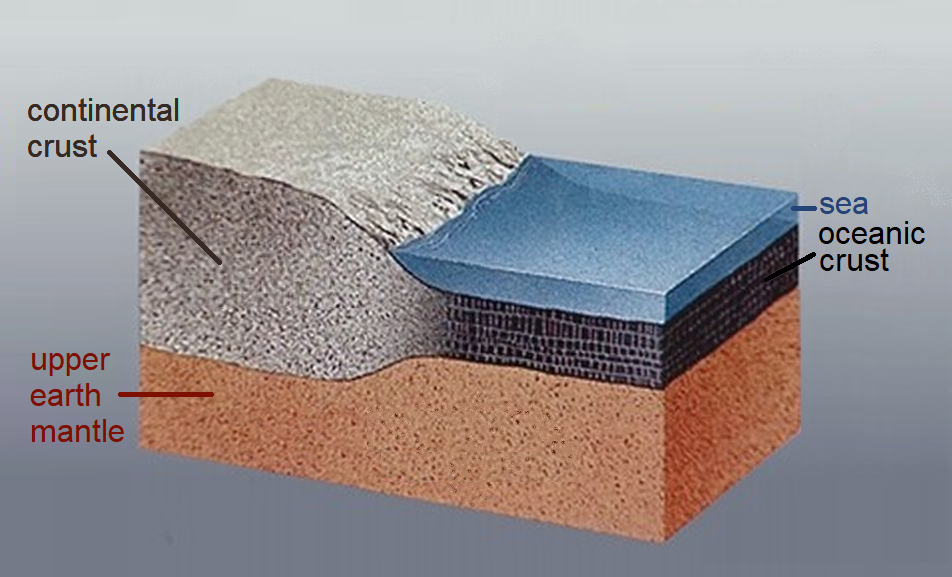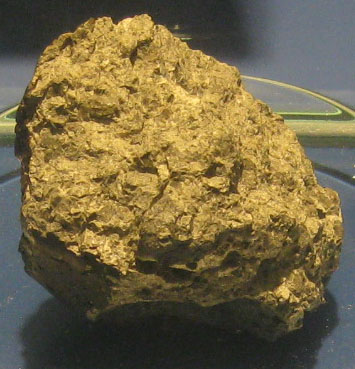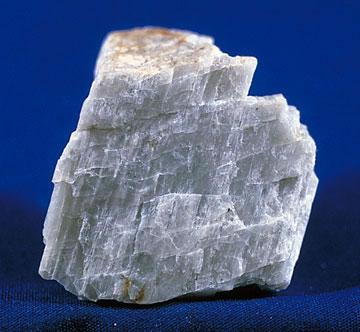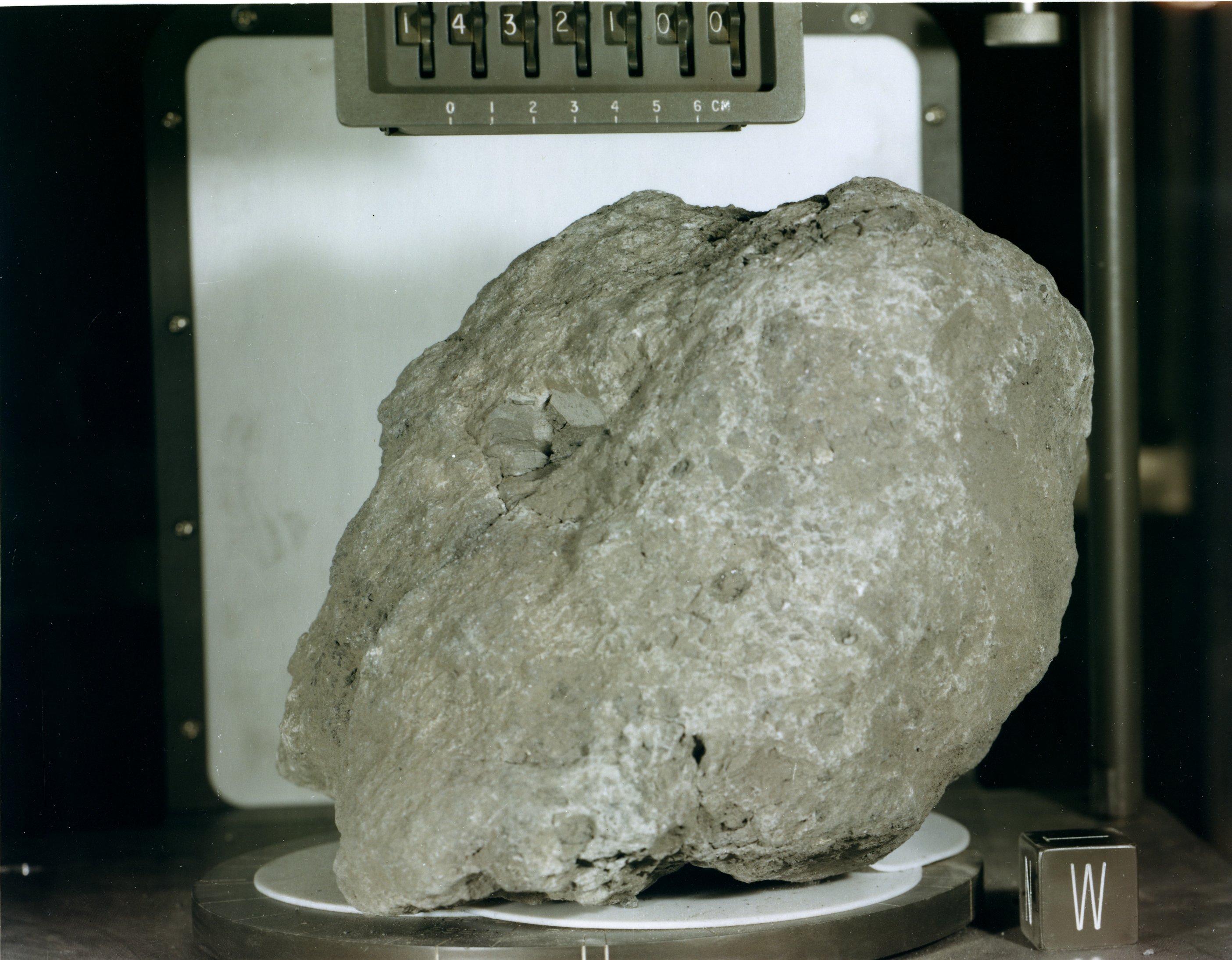|
Crust (geology)
In geology, the crust is the outermost solid shell of a planet, dwarf planet, or natural satellite. It is usually distinguished from the underlying mantle by its chemical makeup; however, in the case of icy satellites, it may be defined based on its phase (solid crust vs. liquid mantle). The crusts of Earth, Mercury, Venus, Mars, Io, the Moon and other planetary bodies formed via igneous processes and were later modified by erosion, impact cratering, volcanism, and sedimentation. Most terrestrial planets have fairly uniform crusts. Earth, however, has two distinct types: continental crust and oceanic crust. These two types have different chemical compositions and physical properties and were formed by different geological processes. Types of crust Planetary geologists divide crust into three categories based on how and when it formed. Primary crust / primordial crust This is a planet's "original" crust. It forms from solidification of a magma ocean. Toward the end o ... [...More Info...] [...Related Items...] OR: [Wikipedia] [Google] [Baidu] [Amazon] |
Earth Internal Structure
Earth is the third planet from the Sun and the only astronomical object known to Planetary habitability, harbor life. This is enabled by Earth being an ocean world, the only one in the Solar System sustaining liquid surface water. Almost all of Earth's water is contained in its global ocean, covering Water distribution on Earth, 70.8% of Earth's crust. The remaining 29.2% of Earth's crust is land, most of which is located in the form of continental landmasses within Earth's land hemisphere. Most of Earth's land is at least somewhat humid and covered by vegetation, while large Ice sheet, sheets of ice at Polar regions of Earth, Earth's polar polar desert, deserts retain more water than Earth's groundwater, lakes, rivers, and Water vapor#In Earth's atmosphere, atmospheric water combined. Earth's crust consists of slowly moving tectonic plates, which interact to produce mountain ranges, volcanoes, and earthquakes. Earth's outer core, Earth has a liquid outer core that generates a ... [...More Info...] [...Related Items...] OR: [Wikipedia] [Google] [Baidu] [Amazon] |
Continental Crust
Continental crust is the layer of igneous, metamorphic, and sedimentary rocks that forms the geological continents and the areas of shallow seabed close to their shores, known as '' continental shelves''. This layer is sometimes called '' sial'' because its bulk composition is richer in aluminium silicates (Al-Si) and has a lower density compared to the oceanic crust, called '' sima'' which is richer in magnesium silicate (Mg-Si) minerals. Changes in seismic wave velocities have shown that at a certain depth (the Conrad discontinuity), there is a reasonably sharp contrast between the more felsic upper continental crust and the lower continental crust, which is more mafic in character. Most continental crust is dry land above sea level. However, 94% of the Zealandia continental crust region is submerged beneath the Pacific Ocean, with New Zealand constituting 93% of the above-water portion. Thickness and density The continental crust consists of various layers, with ... [...More Info...] [...Related Items...] OR: [Wikipedia] [Google] [Baidu] [Amazon] |
Allan Hills 84001
Allan Hills 84001 (ALH84001) is a fragment of a Martian meteorite that was found in the Allan Hills in Antarctica on December 27, 1984, by a team of American meteorite hunters from the ANSMET project. Like other members of the shergottite– nakhlite– chassignite (SNC) group of meteorites, ALH84001 is thought to have originated on Mars. However, it does not fit into any of the previously discovered SNC groups. Its mass upon discovery was . In 1996, a group of scientists found features in the likeness of microscopic fossils of bacteria in the meteorite, suggesting that these organisms also originated on Mars. The claims immediately made headlines worldwide, culminating in U.S. president Bill Clinton giving a speech about the potential discovery. These claims were controversial from the beginning, and much of the scientific community ultimately rejected the hypothesis once all the unusual features in the meteorite had been explained without requiring life to be present. Despit ... [...More Info...] [...Related Items...] OR: [Wikipedia] [Google] [Baidu] [Amazon] |
Martian Meteorite
A Martian meteorite is a rock that formed on Mars, was ejected from the planet by an impact event, and traversed interplanetary space before landing on Earth as a meteorite. , 277 meteorites had been classified as Martian, less than half a percent of the 72,000 meteorites that have been classified. The largest complete, uncut Martian meteorite, Taoudenni 002, was recovered in Mali in early 2021. It weighs 14.5 kilograms (32 pounds) and is on display at the Maine Mineral and Gem Museum. There are three groups of Martian meteorite: shergottites, nakhlites and chassignites, collectively known as SNC meteorites. Several other Martian meteorites are ungrouped. These meteorites are interpreted as Martian because they have elemental and isotopic compositions that are similar to rocks and atmospheric gases on Mars, which have been measured by orbiting spacecraft, surface landers and rovers. The term does not include meteorites found on Mars, such as Heat Shield Rock. Histo ... [...More Info...] [...Related Items...] OR: [Wikipedia] [Google] [Baidu] [Amazon] |
Elements (journal)
''Elements: An International Magazine of Mineralogy, Geochemistry, and Petrology'' is a bimonthly peer-reviewed scientific journal published by 18 scientific societies: Mineralogical Society of America, Mineralogical Society of Great Britain and Ireland, Mineralogical Association of Canada, Clay Minerals Society, Geochemical Society, European Association of Geochemistry, International Association of GeoChemistry, Société Française de Minéralogie et de Cristallographie, Association of Applied Geochemists, , , International Association of Geoanalysts, Polskie Towarzystwo Mineralogiczne ( Mineralogical Society of Poland), Sociedad Española de Mineralogía ( Spanish Mineralogical Society), Swiss Society of Mineralogy and Petrology, Meteoritical Society, Japan Association of Mineralogical Sciences and the International Association on the Genesis of Ore Deposits. It was established in January 2005. The editors-in-chief are Richard J. Harrison (2020-2022), Rebecca A. La ... [...More Info...] [...Related Items...] OR: [Wikipedia] [Google] [Baidu] [Amazon] |
Plagioclase
Plagioclase ( ) is a series of Silicate minerals#Tectosilicates, tectosilicate (framework silicate) minerals within the feldspar group. Rather than referring to a particular mineral with a specific chemical composition, plagioclase is a continuous solid solution series, more properly known as the plagioclase feldspar series. This was first shown by the German mineralogist Johann F. C. Hessel, Johann Friedrich Christian Hessel (1796–1872) in 1826. The series ranges from albite to anorthite endmembers (with respective compositions NaAlSi3O8 to CaAl2Si2O8), where sodium and calcium atoms can substitute for each other in the mineral's crystallography, crystal lattice structure. Plagioclase in hand samples is often identified by its polysynthetic crystal twinning or "phonograph record, record-groove" effect. Plagioclase is a major constituent mineral in Earth's crust and is consequently an important diagnostic tool in petrology for identifying the composition, origin and evolutio ... [...More Info...] [...Related Items...] OR: [Wikipedia] [Google] [Baidu] [Amazon] |
Geology Of The Moon
The geology of the Moon (sometimes called selenology, although the latter term can refer more generally to "lunar science") is the structure and composition of the The Moon, Moon, which is quite different from that of Earth. The Moon Atmosphere of the Moon, lacks a true atmosphere outside of a sparse layer of gas. Because of this, the absence of free oxygen and water eliminates erosion due to weather. Instead, the surface is eroded much more slowly through the bombardment of the lunar surface by micrometeorites. It does not have any known form of plate tectonics, along with having a lower gravity compared to Earth. Because of its small size, it cooled faster in the early days of its formation. In addition to impacts, the geomorphology of the lunar surface has been shaped by volcanism, which is now thought to have ended less than 50 million years ago. The Moon is a planetary differentiation, differentiated body, with a crust (geology), crust, mantle (geology), mantle, and planetary ... [...More Info...] [...Related Items...] OR: [Wikipedia] [Google] [Baidu] [Amazon] |
Anorthosite
Anorthosite () is a phaneritic, intrusive rock, intrusive igneous rock characterized by its composition: mostly plagioclase feldspar (90–100%), with a minimal mafic component (0–10%). Pyroxene, ilmenite, magnetite, and olivine are the mafic minerals most commonly present. Anorthosites are of enormous geologic interest, because it is still not fully understood how they form. Most models involve fractional crystallization (geology), separating plagioclase crystals based on their density. Plagioclase crystals are usually less dense than magma; so, as plagioclase crystallizes in a magma chamber, the plagioclase crystals float to the top, concentrating there. Anorthosite on Earth can be divided into five types: # Archean anorthosites # Proterozoic anorthosite (also known as massif or massif-type anorthosite) – the most abundant type of anorthosite on Earth # Layers within Layered intrusion, Layered Intrusions (e.g., Bushveld Igneous Complex, Bushveld and Stillwater igneous com ... [...More Info...] [...Related Items...] OR: [Wikipedia] [Google] [Baidu] [Amazon] |
Cambridge University Press
Cambridge University Press was the university press of the University of Cambridge. Granted a letters patent by King Henry VIII in 1534, it was the oldest university press in the world. Cambridge University Press merged with Cambridge Assessment to form Cambridge University Press and Assessment under Queen Elizabeth II's approval in August 2021. With a global sales presence, publishing hubs, and offices in more than 40 countries, it published over 50,000 titles by authors from over 100 countries. Its publications include more than 420 academic journals, monographs, reference works, school and university textbooks, and English language teaching and learning publications. It also published Bibles, runs a bookshop in Cambridge, sells through Amazon, and has a conference venues business in Cambridge at the Pitt Building and the Sir Geoffrey Cass Sports and Social Centre. It also served as the King's Printer. Cambridge University Press, as part of the University of Cambridge, was a ... [...More Info...] [...Related Items...] OR: [Wikipedia] [Google] [Baidu] [Amazon] |
Oldest Dated Rocks
The oldest dated rocks formed on Earth, as an aggregate of minerals that have not been subsequently broken down by erosion or melted, are more than 4 billion years old, formed during the Hadean Eon of Earth's geological history, and mark the start of the Archean Eon, which is defined to start with the formation of the oldest intact rocks on Earth. Archean rocks are exposed on Earth's surface in very few places, such as in the geologic shields of Canada, Australia, and Africa. The ages of these felsic rocks are generally between 2.5 and 3.8 billion years. The approximate ages have a margin of error of millions of years. In 1999, the oldest known rock on Earth was dated to 4.031 ±0.003 billion years, and is part of the Acasta Gneiss of the Slave Craton in northwestern Canada. Researchers at McGill University found a rock with a very old model age for extraction from the mantle (3.8 to 4.28 billion years ago) in the Nuvvuagittuq greenstone belt on the coast of Hudson Bay, i ... [...More Info...] [...Related Items...] OR: [Wikipedia] [Google] [Baidu] [Amazon] |
Elsevier
Elsevier ( ) is a Dutch academic publishing company specializing in scientific, technical, and medical content. Its products include journals such as ''The Lancet'', ''Cell (journal), Cell'', the ScienceDirect collection of electronic journals, ''Trends (journals), Trends'', the ''Current Opinion (Elsevier), Current Opinion'' series, the online citation database Scopus, the SciVal tool for measuring research performance, the ClinicalKey search engine for clinicians, and the ClinicalPath evidence-based cancer care service. Elsevier's products and services include digital tools for Data management platform, data management, instruction, research analytics, and assessment. Elsevier is part of the RELX Group, known until 2015 as Reed Elsevier, a publicly traded company. According to RELX reports, in 2022 Elsevier published more than 600,000 articles annually in over 2,800 journals. As of 2018, its archives contained over 17 million documents and 40,000 Ebook, e-books, with over one b ... [...More Info...] [...Related Items...] OR: [Wikipedia] [Google] [Baidu] [Amazon] |
Tectonophysics (journal)
''Tectonophysics, The International Journal of Geotectonics and the Geology and Physics of the Interior of the Earth'' is a weekly peer-reviewed scientific journal published by Elsevier. It was established in 1964 and covers the field of tectonophysics, including kinematics, structure, composition, and dynamics of the solid Earth at all scales. Organization The editors-in-chief are Samuel Angiboust ( ENS de Lyon), Jean-Philippe Avouac (California Institute of Technology), Ramon Carbonell (Spanish National Research Council), Rob Govers (Utrecht University), Zheng Xiang Li (Curtin University), and Kelin Wang (Geological Survey of Canada). Abstracting and indexing This journal is abstracted and indexed in over fifty databases, including Current Contents, GeoRef, Inspec, Scopus and Web of Science. Notable articles According to the ''Journal Citation Reports'', ''Tectonophysics'' has a 2011 impact factor The impact factor (IF) or journal impact factor (JIF) of an academic ... [...More Info...] [...Related Items...] OR: [Wikipedia] [Google] [Baidu] [Amazon] |






